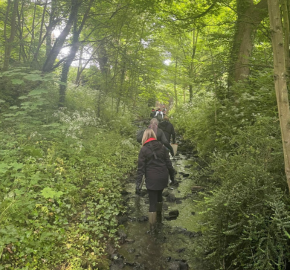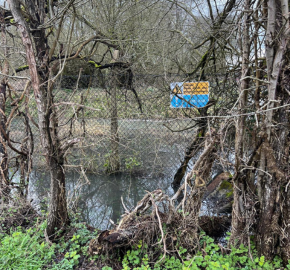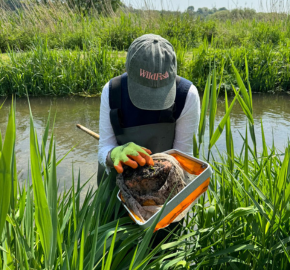Warming water temperatures and the impact on riverfly populations
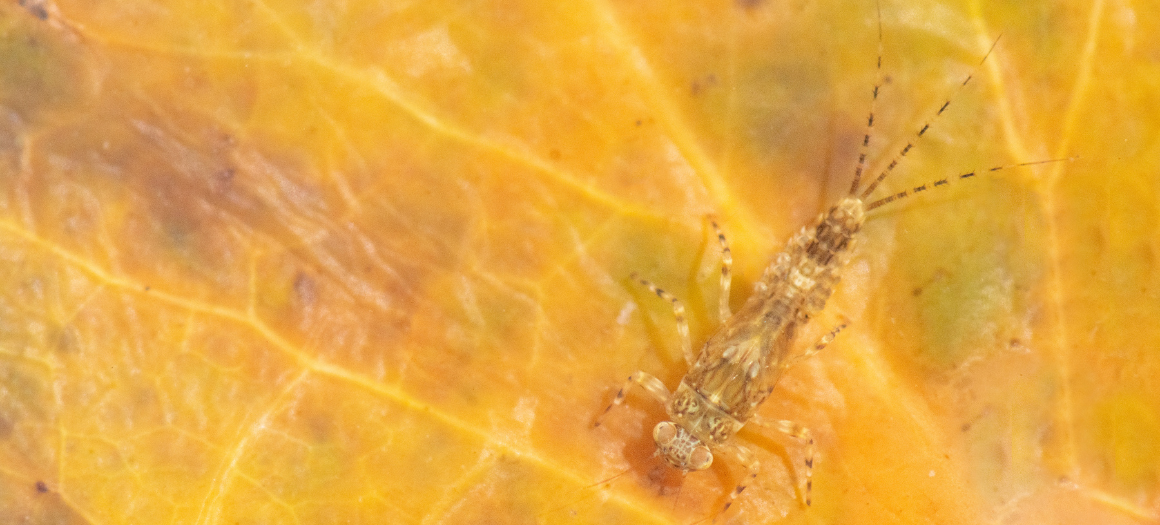
Riverfly populations are highly vulnerable to climate change. Warming water temperatures in particular have a profound effect on their life cycles and reduce the area of suitable habitats in which they can live. The need for cooler conditions will drive sensitive insects into upland catchments and headwaters where increasingly isolated populations are at greater risk of being lost.
It might be a bit British to open with a line about the weather… but what weather we’re having!
In recent months, the UK has experienced its hottest June and the sixth wettest July on record (the wettest ever in Northern Ireland). While the sixth of anything might not seem that impressive it does highlight the fact that we are experiencing more variable and extreme weather events that put our natural habitats and wildlife at risk.
Changes in nature
Climate change fuelled by human activity is one of the key drivers in the frightening biodiversity declines we’re seeing play out in the natural world. Our freshwater habitats and animals are particularly vulnerable, as water quality and quantity are closely tied to the surrounding environmental conditions [1]. For example, warmer water holds less dissolved oxygen but also increases metabolic rates in aquatic wildlife. This results in animals’ bodies demanding more oxygen when there is less available in the environment.
There are two key routes by which climate change is expected to most impact freshwater habitats, altering their flow regimes and water chemistry [2]:
1. Increasing water temperatures.
2. Changes to weather patterns (e.g., changes to amounts of rainfall and drought).
Climate change and the ever-increasing demands of a growing population compound the pressures facing freshwater habitats. Just think back over the last few months, it is easy to imagine the stress our waters have been under. A hot, dry June left rivers more vulnerable to excessive removal of water while an unseasonably wet July increased the risk of pollution from agricultural run-off and sewage overflows.
The significance of invertebrates in understanding changes to freshwater
The majority of freshwater animals are invertebrates and insects are estimated to make up 60% of this diversity [3]. Insects are vitally important to the health of our freshwater habitats due to their role in key biological processes such as decomposition, the cycling of nutrients, and food web dynamics [4]. Importantly, they act as invaluable guardians for our waterways as indicators of environmental stress.
Our SmartRivers team of citizen scientists help to identify pressures impacting rivers across the country. One of the areas volunteers focus on in their analysis is the EPT riverfly species; mayfly (Ephemeroptera), stonefly (Plecoptera) and caddisfly (Trichoptera).
The impacts of warming on freshwater insects
It seems inevitable that this century global temperature will exceed 1.5 degrees centigrade of warming and even this relatively modest prediction will have severe implications for freshwater systems [1]. It’s important that we understand what impact these warming temperatures are having on our insect populations if we are to safeguard them.
- Understanding the thermal niche
Insects are poikilothermic (their body temperature varies with the environment) which means they are particularly sensitive to changes in temperature [5]. Research has revealed wide-ranging responses to global warming; from the emergence of smaller adults earlier in the year to changes in the geographical distribution of species [6]. Some insects may be able to tolerate a wider range of temperatures, but many have adapted to specific conditions, which they now rely on in order to thrive.
A thermal niche is the ideal temperature range for a particular species to live in. As water temperatures increase many species may need to shift their geographical range to maintain a comfortable temperature. Here in the Northern Hemisphere, a freshwater insect seeking cooler conditions would either need to move further north to water bodies at higher latitudes and/or upstream to higher elevations.
- Shifting geographical ranges
Animals shifting their geographical ranges in response to warming temperatures is a well-known phenomenon, but if/how/why a particular species disperses is a complicated picture. One factor that can have a very strong effect is the availability of suitable habitat in the area that a species would need to move into in order to remain in its thermal niche. Animals that are able to live in a broader range of habitats are expected to be better at colonising new areas in response to global warming, compared to species with specialised habitat requirements managing to find a suitable area of new habitat [7].
Animals moving to new habitats is even more concerning if we think about it in the context of the declining condition of freshwater habitats across the UK. The declining quality of these ecosystems constrains species already displaced by warming temperatures even further.
Factors that will determine the successful dispersal of invertebrates
A freshwater insect’s ability to disperse and seek cooler conditions is primarily dependent on its overall size and flight period during the more mobile adult life stage [8].
Larger insects with relatively long flight periods are expected to be better equipped to cope with the challenge and colonise more freely. This is evidenced by the observed northerly movements of British dragonfly and damselfly species since the 1960s [9]. A group of insects well known for their aerodynamic prowess. On the other hand, smaller insects with relatively short flight periods as adults appear to be less capable of overcoming the challenge. This is highly concerning for our riverfly populations. A recent assessment of the vulnerability of British riverflies to climate change has shown that large proportions of mayflies (67%), stoneflies (86%), and caddisflies (42%) have a short flight period [10]. The situation looks even more bleak for stoneflies as on top of this 43% of species rely on colder temperatures. Our riverfly species are not well known for their dispersal abilities between waters, although within a river there can be a reasonable amount of up and downstream movement of individuals [11].
Seeking refuge in upland waters may come at a higher risk
While upland waters have the potential to provide colder refuges for freshwater insects, it’s important to note that these areas are also predicted to be most adversely affected by climate change [10]. So, the species that naturally occupy these colder habitats are already at higher risk, where they become trapped in isolated ‘islands’ of water of acceptable temperature.
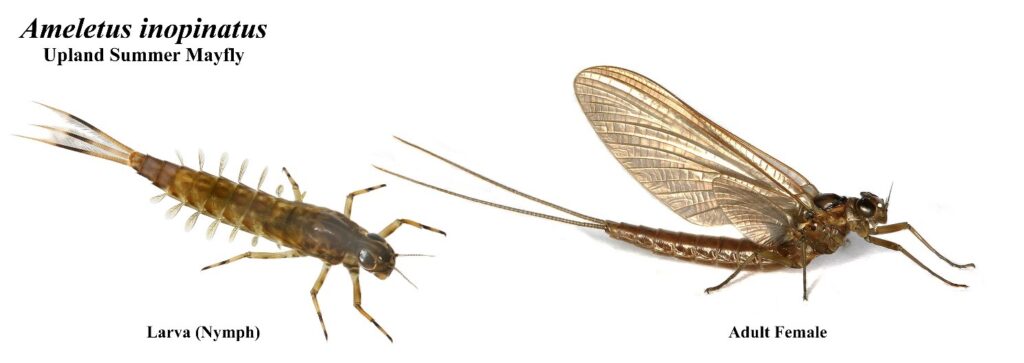
Figure 1: The upland summer mayfly (Ameletus inopinatus) is the only alpine-arctic mayfly species in Britain and is becoming increasingly isolated in high altitude upland streams as global temperatures increase. ©CyrilBennett
Spotlight: upland summer mayfly
The upland summer mayfly (Ameletus inopinatus) is the only arctic-alpine relic mayfly species in the UK and its range is contracting as water temperatures increase. The tiny upland streams where this mayfly can be found in the Cairngorms dry out completely in the summer months. That means last year’s nymphs are on a tight timeline to complete their development and breed before this happens. Recent work has shown that snow cover appears to play a role in insulating the high-elevation streams this species lives in over winter, creating a more stable water temperature that enables the nymphs to continue growing [12]. However, overwinter snow cover in the Cairngorms is decreasing and warmer winter months also lead to the snow melting earlier. This reduces the amount of meltwater feeding streams later in the year. This is bad news for the mayfly as the nymph’s development is slower in the uninsulated streams, meanwhile, the period of time they have to develop shrinks as the streams dry out earlier in the year [12]. Vulnerable species like the upland summer mayfly have already been pushed into isolated pockets of suitable habitat and as climate change continues to impact these areas, local populations of mayfly will be left with nowhere else to go.
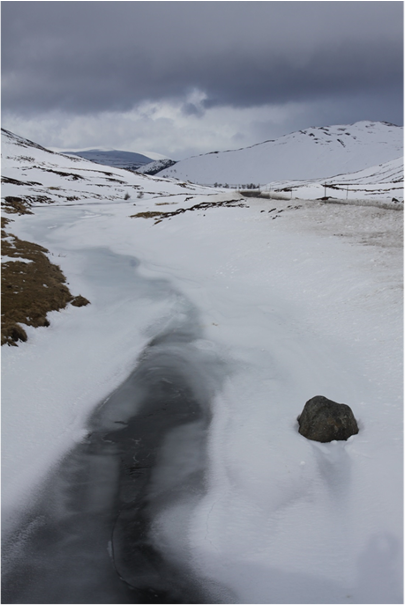
Figure 2: The upland summer mayfly overwinters in small upland streams that experience harsh climates. Here the Cairnwell Burn, Cairngorms is nearly snowbound. Image credit David Pryce.
The speed of climate change is leaving more species unable to keep up
Climate change and species range shifts are normal global processes that naturally happen over long timescales. The current climate shifts driven by human activity are frighteningly fast in comparison and many species are simply unable to keep up with the pace of change.
It’s not only our vulnerable and isolated riverfly species whose lives can be affected by warming water temperatures. There will be much broader changes happening across our waters that could increase the risk for a wide range of species.
Spotlight: UK’s largest mayfly
Our largest mayfly species in the UK is known as the green drake (Ephemera danica). As water temperatures increase these mayflies shift from a two-year life cycle to developing in a single year [13,14]. A consequence of developing faster is that the adults are smaller and smaller females produce significantly fewer eggs [15]. This will inevitably have a negative effect on the population sizes of future generations. These smaller individuals are also likely to be less physically able to disperse and seek cooler waters. An additional concern is that in a one-year lifecycle, the majority of a mayfly population would emerge together as adults. These populations could then be more vulnerable to things like adverse weather disrupting the short flight period and preventing females from returning to the river to lay eggs [13]. Fortunately, the availability of cooler conditions can mitigate these changes. This has been demonstrated in the River Dove where, in areas of the river fed by cool groundwater, mayflies maintained a two-year life cycle [14]. In this two-year life cycle nymphs can overwinter, both growing larger and increasing a population’s resilience to disturbance in future years.
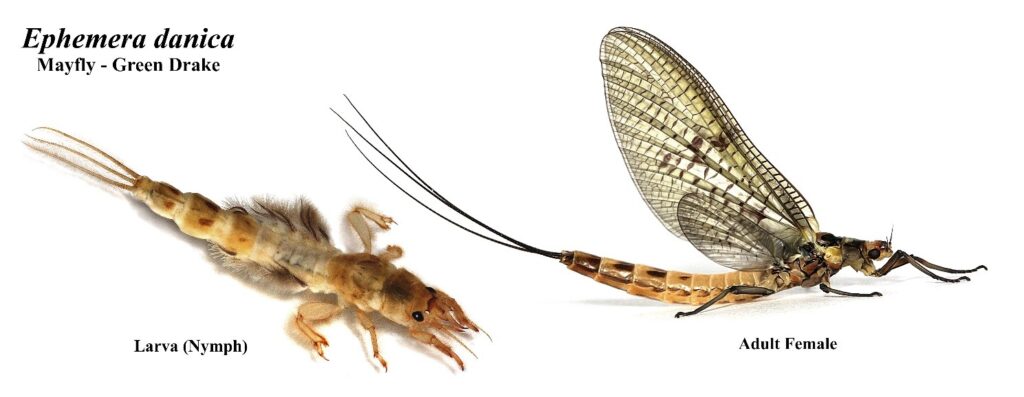
Figure 3: The mayfly (Ephemera danica) can overwinter in a two-year lifecycle resulting in larger adults carrying more eggs. Warming temperatures can push this species towards developing within a single year. ©CyrilBennett
Breaking the pattern of destruction caused by climate change
Climate change and global warming are pervasive large-scale problems that aren’t going anywhere in a hurry. We know that global temperature trends are predicted to continue increasing and that these increases are having adverse effects on freshwater insect populations.
We cannot afford to add fuel to this fire by decimating our freshwater habitats with inappropriate management schemes and treating them as communal waste disposal units. The impacts of human activity or inactivity on our waterways reduce their resilience to climate change. We have the power to change this.
Global warming is predicted to shift freshwater insects to upland waters and headwaters, while also having the strongest impacts in these areas. In the assessment of British riverfly species, our most at-risk species to climate change were associated with upland areas, although some were identified in lowland areas where they are associated with cool springs and headwaters [10]. It seems clear that these habitats are a valuable resource with regard to safeguarding freshwater insect biodiversity in a warming world. They not only have the capacity to broadly act as thermal refugia (an area where organisms can survive through periods of unfavourable conditions) for freshwater insects but are also the last holdouts for vulnerable riverfly like the Upland Summer Mayfly. In addition to this, habitats like shaded woodland streams and groundwater-fed chalk streams have the potential to be important areas with cooler water temperatures.
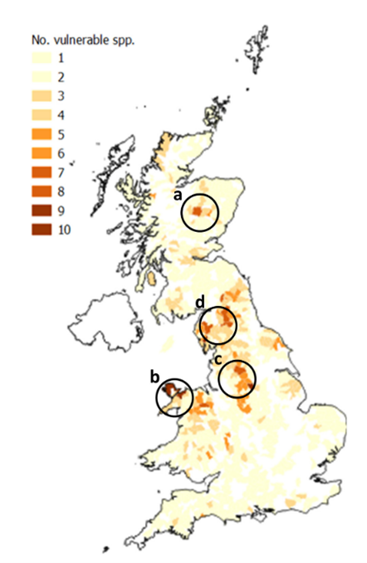
Figure 4: reproduced from Macadam et al, 2022. This map shows the number of EPT riverfly species vulnerable to climate change in Britain. The greatest species concentrations are associated with upland areas in the Cairngorms (a), Snowdonia (b), Peak District (c), and Lake District (d). These areas would be effective to target with conservation and restoration efforts.
Safeguarding freshwater invertebrates and their habitats from warming temperatures
We can all make a conscious effort to reduce our carbon footprint and adopt more sustainable practices to help protect freshwater habitats in the longer term. In the short term we need focussed and innovative conservation and habitat restoration schemes. For example, existing schemes that are strategically planting woodland along waterways to create patches of shade in the summer to reduce water temperatures in key areas. We need to actively monitor our changing water temperatures and the impacts these have on freshwater insect populations if we are to protect them.
More generally there are effective methods with which to target smaller water bodies [16];
1. Restoration of the natural water channels.
2. Encourage natural vegetation along the banks.
3. Manage human disturbance in the catchment area.
It is imperative that we reduce human pressures and push for the greater protection of the freshwater habitats that will act as climate refuges for freshwater invertebrates populations in the difficult years to come.
Thanks to Craig Macadam and Cyril Bennett for their support in preparing this blog.
List of references
- Capon, S. J., Stewart-Koster, B. & Bunn, S. E. Future of Freshwater Ecosystems in a 1.5°C Warmer World. Front Environ Sci 9, (2021).
- Whitehead, P., Butterfield, D. & Wade, A. Potential impacts of climate change on river water quality. Scientific Report -SC070043/SR1 (2008).
- Collen, B. et al. Spineless status and trends of the world’s invertebrates. Zoological Society of London, United Kingdom (2012).
- Macadam, C. R. & Stockan, J. A. More than just fish food: Ecosystem services provided by freshwater insects. Ecol Entomol 40, (2015).
- Harvey, J. A. et al. Scientists’ warning on climate change and insects. Ecological Monographs 93, (2023).
- Bonacina, L., Fasano, F., Mezzanotte, V. & Fornaroli, R. Effects of water temperature on freshwater macroinvertebrates: a systematic review. Biological Reviews 98, (2023).
- Platts, P. J. et al. Habitat availability explains variation in climate-driven range shifts across multiple taxonomic groups. Sci Rep 9, (2019).
- Macadam, C. Personal communication. (2023).
- Hickling, R., Roy, D. B., Hill, J. K. & Thomas, C. D. A northward shift of range margins in British Odonata. Glob Chang Biol 11, (2005).
- Macadam, C. R., England, J. & Chadd, R. The vulnerability of British aquatic insects to climate change. Knowl Manag Aquat Ecosyst 423, (2022).
- Bennett, C. J. Personal Communication. (2023).
- Macadam, C. R., Kitchen, L. & Yeomans, W. E. Water temperature and the growth of Ameletus inopinatus (Ephemeroptera: Ameletidae) in the Cairngorms, Scotland. Zoosymposia 24 (2023).
- Bennett, C. J. A seven-year study of the life cycle of the mayfly Ephemera danica. Freshwater Forum 27, (2007).
- Everall, N. C., Johnson, M. F., Wilby, R. L. & Bennett, C. J. Detecting phenology change in the mayfly Ephemera danica: Responses to spatial and temporal water temperature variations. Ecol Entomol 40, (2015).
- Bennett, C. J. The ecology of mayflies (Ephemeroptera) in the upper reaches of the river Wey in Surrey. University of London, PhD Thesis, (1996).
- Riley, W. D. et al. Small Water Bodies in Great Britain and Ireland: Ecosystem function, human-generated degradation, and options for restorative action. Science of the Total Environment 645, (2018).

